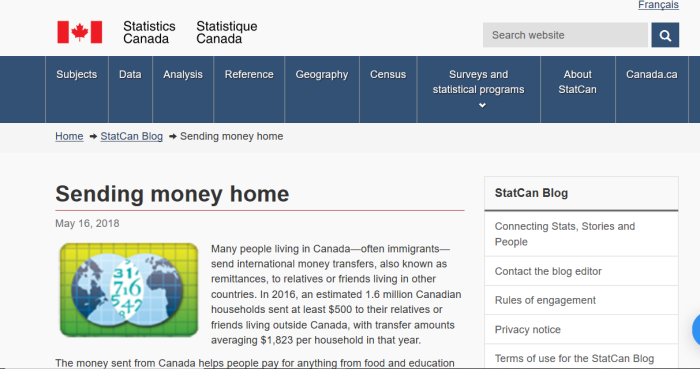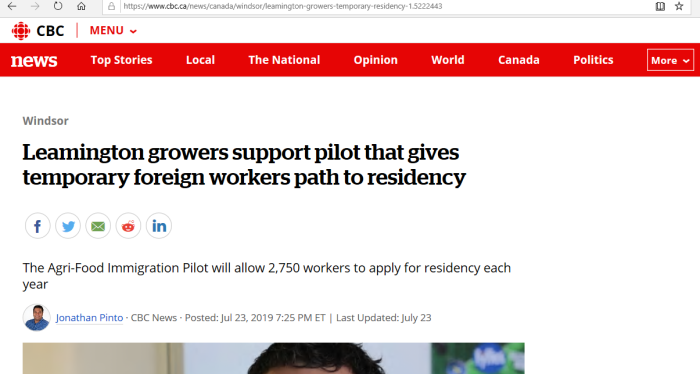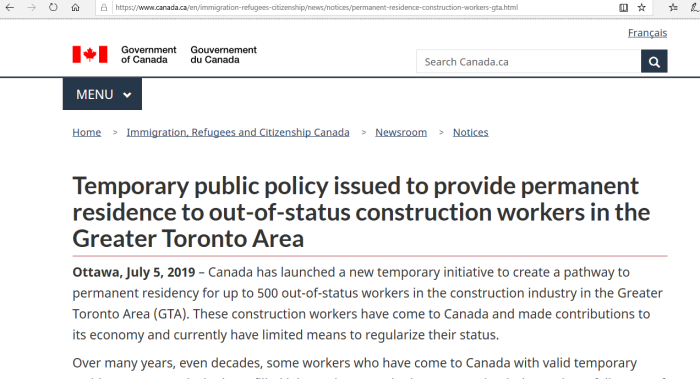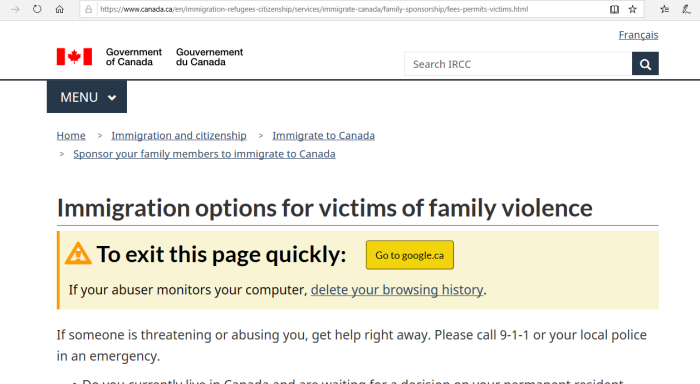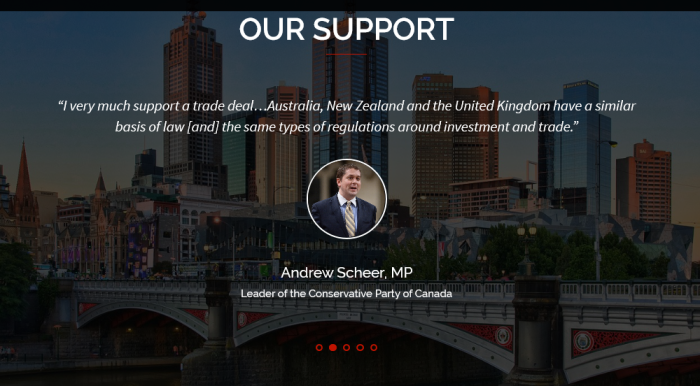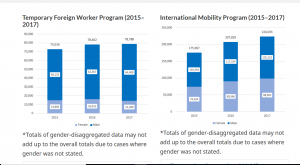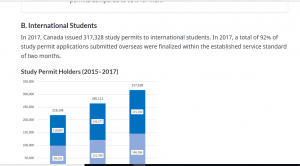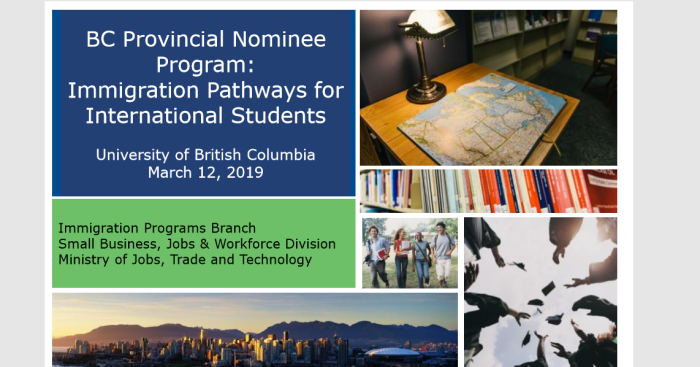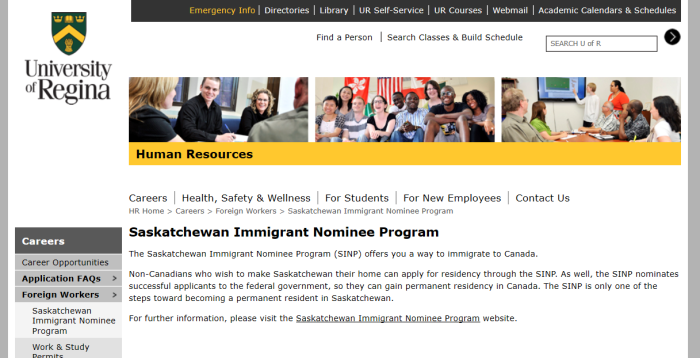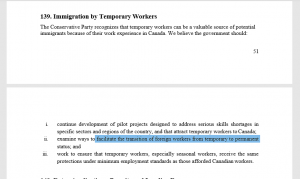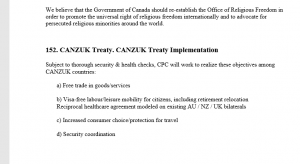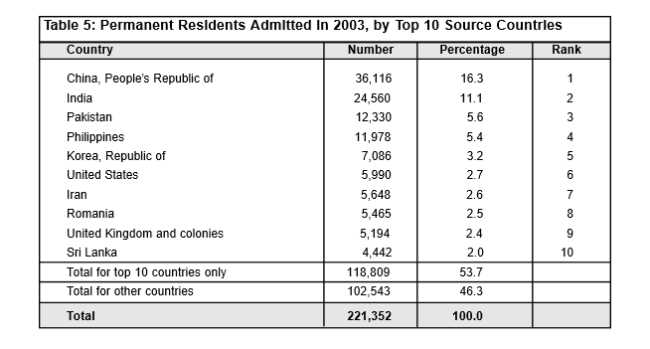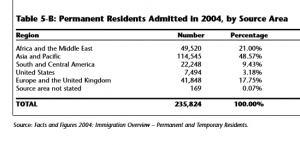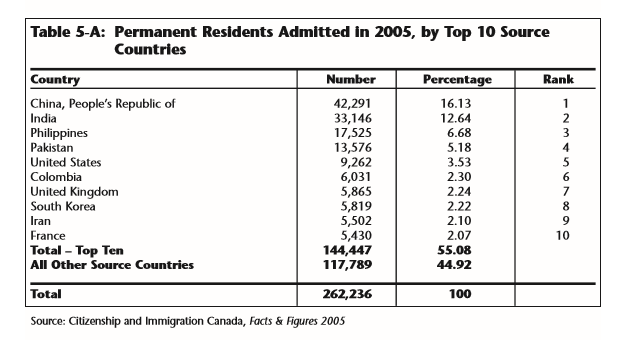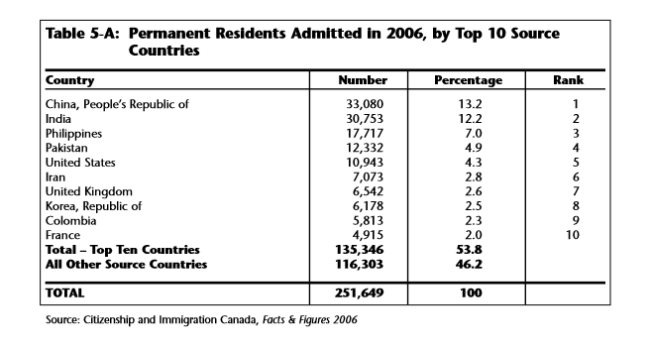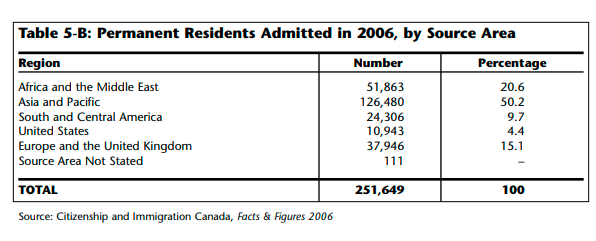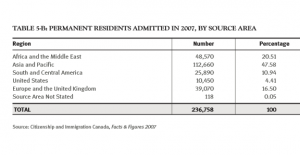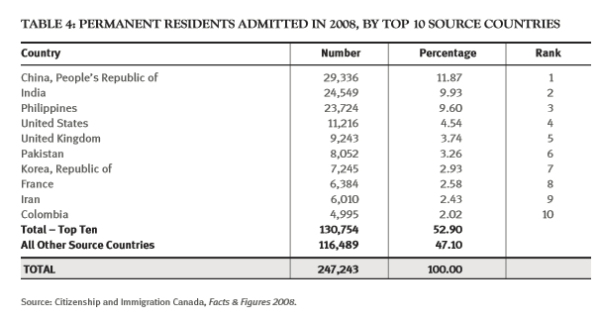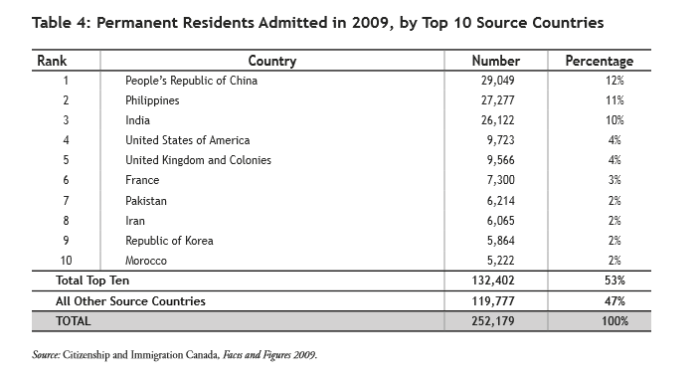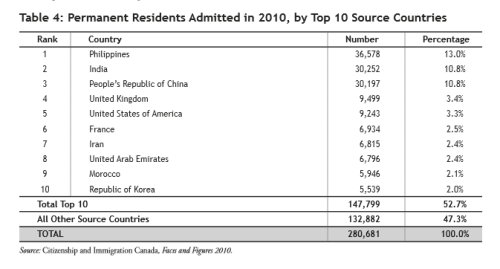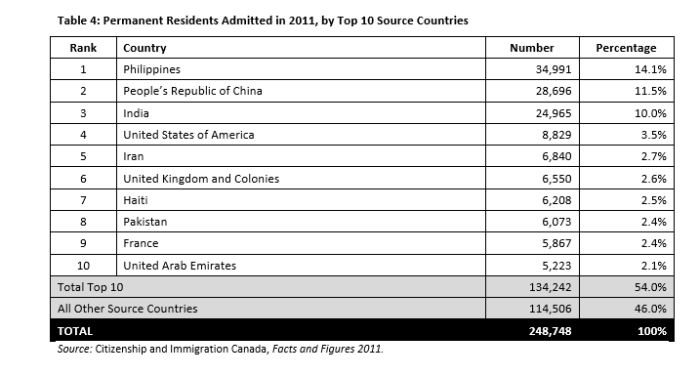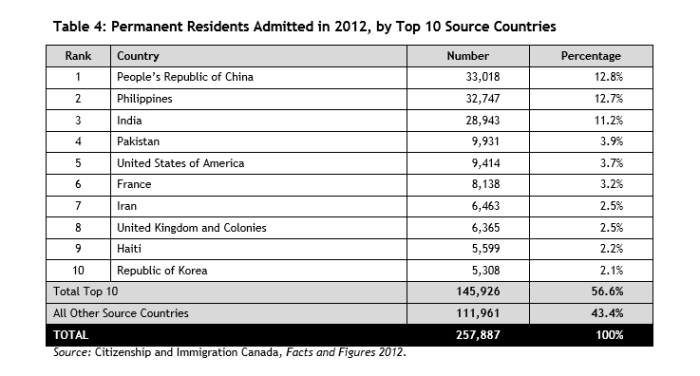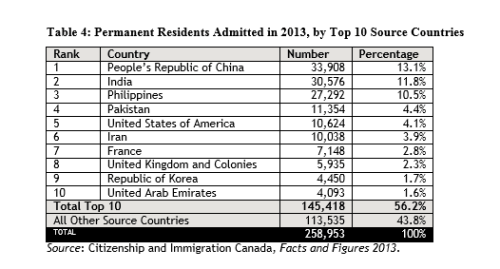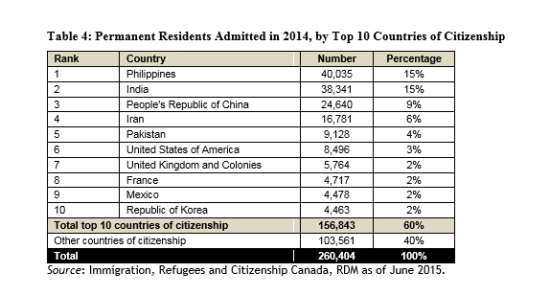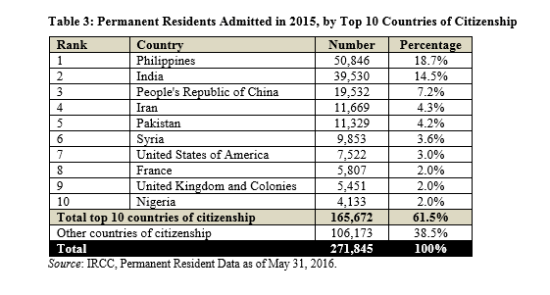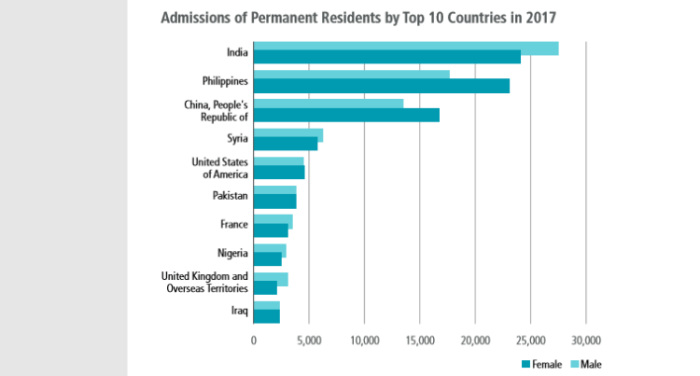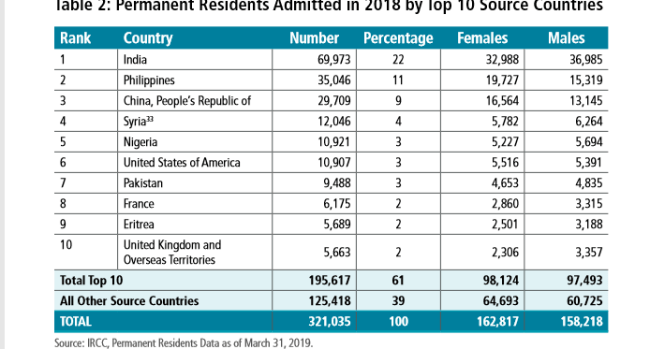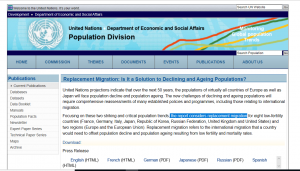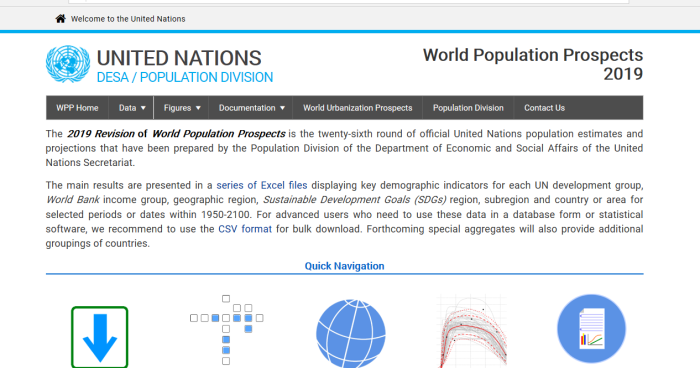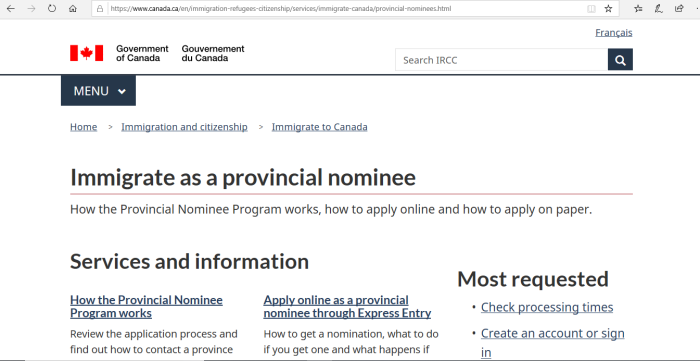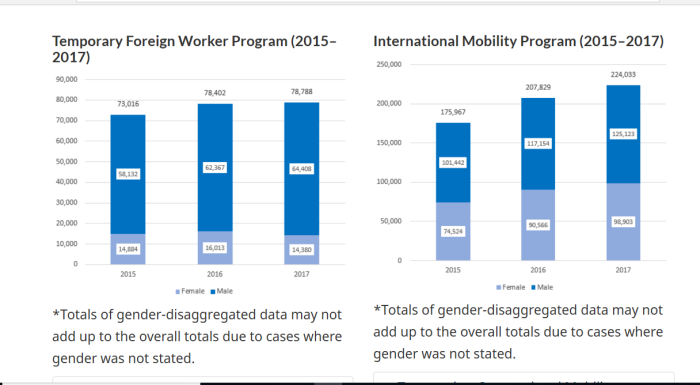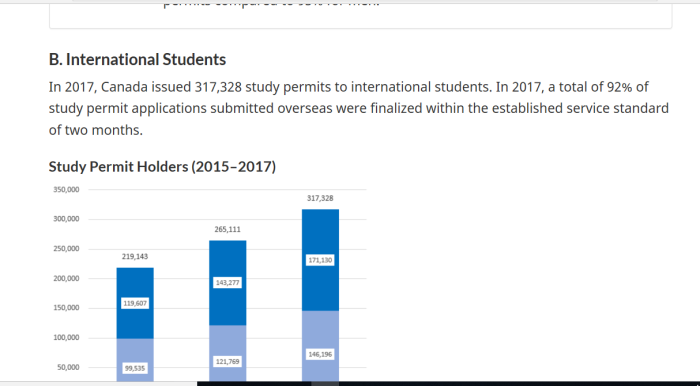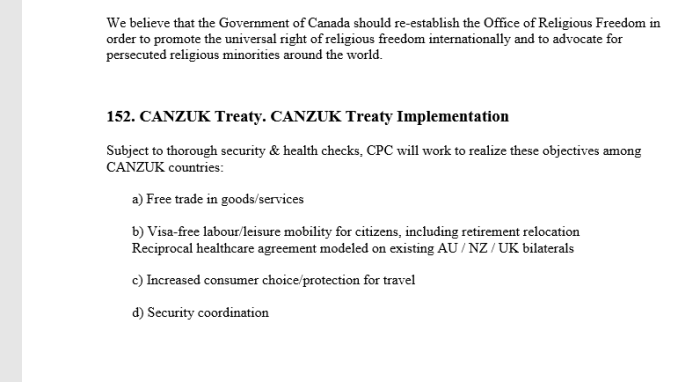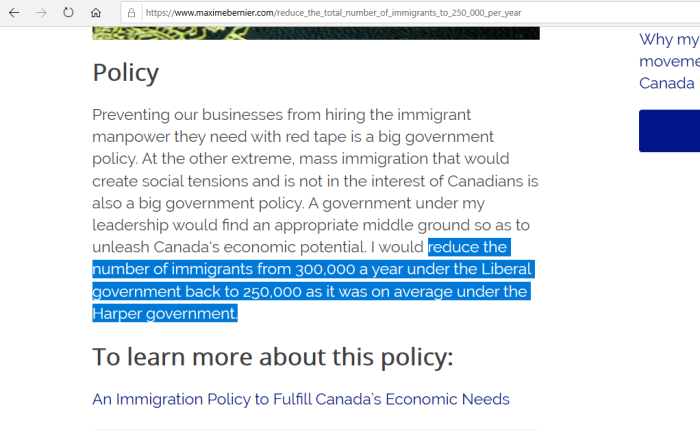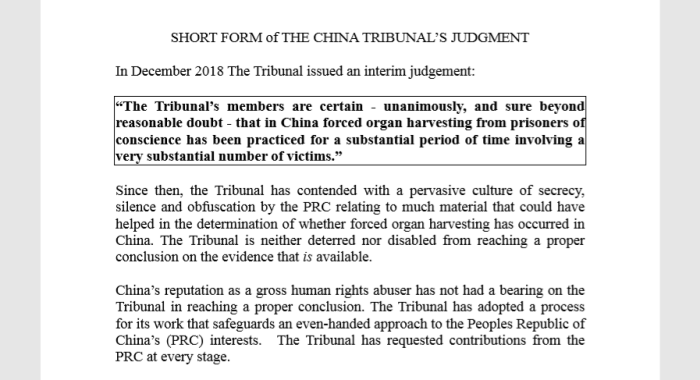(StatsCan on % int’l students becoming permanent residents)

(StatsCan findings: close to 30% eventually become PR)
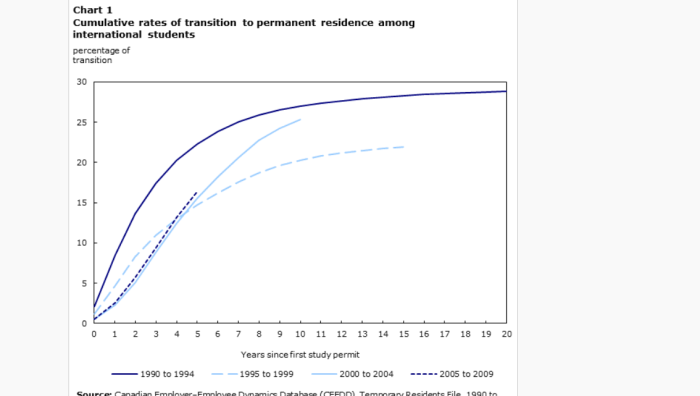
(StatsCan: latest cohort TFW/IMP transitioning at higher rates)
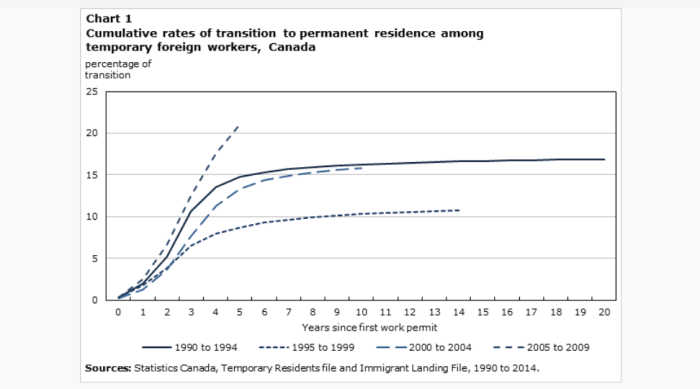
(StatsCan on int’l students, earnings growth)

(Federal Gov’t education strategy 2019-2024)
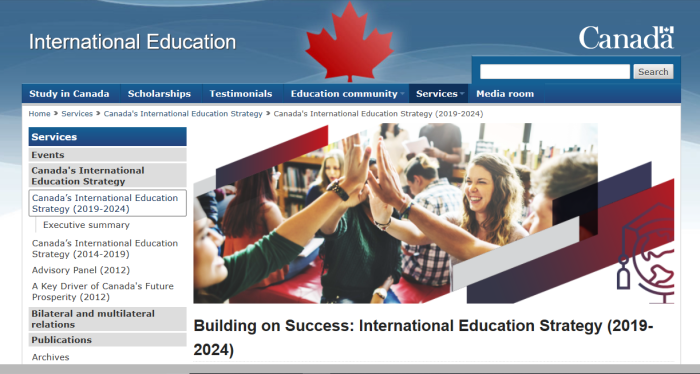
(Status of “Temporary” Foreign Workers transitioning to PR)
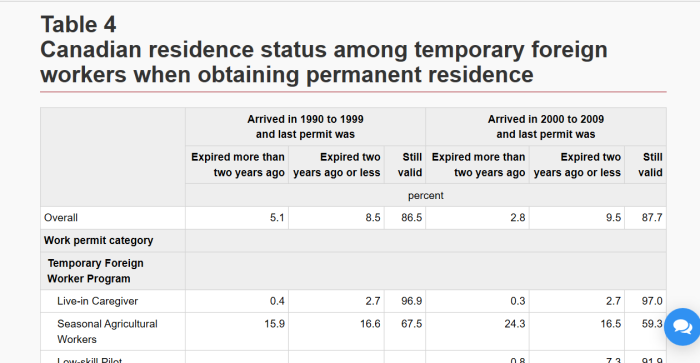
(Program launched in July 2019: PR-Path for illegals)
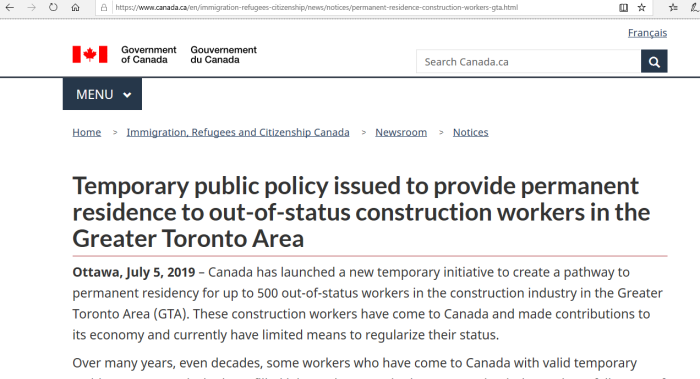
1. Mass LEGAL Immigration In Canada
Despite what many think, LEGAL immigration into Canada is actually a much larger threat than illegal aliens, given the true scale of the replacement that is happening. What was founded as a European (British) colony is becoming unrecognizable due to forced demographic changes. There are also social, economic, environmental and voting changes to consider. See this Canadian series, and the UN programs for more detail. Politicians, the media, and so-called “experts” have no interest in coming clean on this.
CLICK HERE, for UN Genocide Prevention/Punishment Convention.
CLICK HERE, for Barcelona Declaration & Kalergi Plan.
CLICK HERE, for UN Kalergi Plan (population replacement).
CLICK HERE, for UN replacement efforts since 1974.
CLICK HERE, for tracing steps of UN replacement agenda.
Note: If there are errors in calculating the totals, please speak up. Information is of no use to the public if it isn’t accurate.
2. Important Links
(1) https://www150.statcan.gc.ca/n1/pub/75-006-x/2015001/article/14299-eng.htm
(2) http://archive.is/wip/B1ikY
(3) https://www150.statcan.gc.ca/n1/daily-quotidien/170822/dq170822c-eng.htm
(4) http://archive.is/wip/s4x6I
(5) https://www.international.gc.ca/education/strategy-2019-2024-strategie.aspx?lang=e
(6) http://archive.is/wip/NbQof
(7) https://www150.statcan.gc.ca/n1/pub/11f0019m/2017389/tbl/tbl04-eng.htm
(8) http://archive.is/wip/O8GB0
(9) https://www150.statcan.gc.ca/n1/pub/11f0019m/11f0019m2017389-eng.htm
(10) http://archive.is/wip/oc9vW
(11) https://www.ctvnews.ca/canada/canada-to-begin-collecting-exit-passport-data-1.2947418
(12) http://archive.is/wip/feDOA
(13) https://www.cbsa-asfc.gc.ca/btb-pdf/ebsiip-asfipi-eng.html
(14) http://archive.is/wip/krWR3
(15) https://globalnews.ca/news/6040749/canada-border-services-agency-arrest-warrants-cancelled/
(16) http://archive.is/4jQA9
(17) https://www.canada.ca/en/immigration-refugees-citizenship/news/notices/permanent-residence-construction-workers-gta.html
(18) http://archive.is/e6OYZ
(19) https://canadianlabour.ca/permanentresidence/
(20) http://archive.is/s3pq6
(21) https://www.thestar.com/news/canada/2008/05/07/41000_illegal_immigrants_gone_missing.html
(22) http://archive.is/bayYs
(23) https://torontosun.com/2017/03/14/the-high-cost-of-illegal-migrants/wcm/a2cdce17-4808-48df-9569-1247cba8bcf0
(24) http://archive.is/wip/Xk9l4
2004.annual.immigration.report.to.parliament
2005.annual.immigration.report.to.parliament
2006.annual.immigration.report.to.parliament
2007.annual.immigration.report.to.parliament
2008.annual.immigration.report.to.parliament
2009.annual.immigration.report.to.parliament
2010.annual.immigration.report.to.parliament
2011.annual.immigration.report.to.parliament
2012.annual.immigration.report.to.parliament
2013.annual.immigration.report.to.parliament
2014.annual.immigration.report.to.parliament
2015.annual.immigration.report.to.parliament
2016.annual.immigration.report.to.parliament
2017.annual.immigration.report.to.parliament
2018.annual.immigration.report.to.parliament
2019.annual.immigration.report.to.parliament
3. Context For This Article
The topic of “temporary” mass migration to Canada is discussed here a lot. This is partly because of their size, and partly because various “temporary” programs actually lead to Permanent Resident status.
Three groups which receive regular attention are these:
(a) Temporary Foreign Worker Program;
(b) International Mobility Program;
(c) Student Visas
Now, it has been asked several times: how many of these people actually do stay? Of course, this is a logical follow-up question. Obviously, not everyone will stay after their work of schooling ends.
However, it’s not so easy to answer. Yes, we have data suggesting that approximately one quarter or more (25-30%) do attain PR status. That is pretty straightforward information to get a hold of.
But after that, things are much less clear. Until 2016, Canada did not track people leaving the country (only entering). Even today it does not cover everyone. This is unlike nearly every other developed nation, which tracks both entry and exits across borders. Also, the Federal Government does not make easily available (if it even knows), how many people apply for other visas or programs. Worse, it has been discovered that the CBSA deletes older arrest warrants. Additionally, there is little reliable information accessible on how many people are working illegally, or receiving public benefits illegally.
Back to the question of: “How many people stay?”
My answer: At least 25-30%. Probably a lot more.
4. People Leaving Canada Aren’t Tracked

In 2016, the Federal Government announced plans to start collecting exit information from people leaving the country. This really is common sense. While we (theoretically) know how many people, who, and when, are ENTERING Canada, until now they Government doesn’t track who is LEAVING. Perhaps we just take it on face that everyone leaves when they should.
And one of the major benefits stated is to help reduce immigration fraud. If a person is “counting time” towards living in Canada, but doesn’t actually live here, then the Immigration Ministry should know about it.
When this does get implemented, then a gaping hole in Canadian border security should be fixed, right? Maybe not.
Canada collects basic biographic information on travellers who enter and leave the country by land to ensure complete travel history information is available, thereby strengthening the management of our border.
Biographic entry information is routinely collected directly from all travellers entering Canada upon presentation to a CBSA officer at a port of entry as part of the primary inspection process. Canada also collects exit information in the land mode. Canada receives biographic entry information from the United States (U.S.) on all travellers who enter the U.S. through a land border crossing, thereby enabling the creation of a Canadian exit record.
Regulatory amendments for the air mode are expected to come into force in Summer 2020. Once fully implemented in the air mode, Canada will collect basic exit information directly from air carriers through passenger manifests. Exit information collected in the air mode will not be shared with the U.S.
The collection of exit information enhances the CBSA’s ability to manage border security by closing the loop on an individual’s travel history. This allows the CBSA to focus efforts and resources towards unknown or higher risk travellers.
This still isn’t fully implemented, and won’t be until at least 2020. That’s right, these changes were announced in 2016, and over three years later, are not fully implemented. Guess the potential fraud and security risks aren’t that great.
Right now, departures by air are not recorded by CBSA. Unless someone is travelling to the United States, (and even then not always) he/she is flying in a plane. Boating isn’t really a practical solution for international travel to and from Canada.
5. CBSA Cancels Old Arrest Warrants
Currently, there are more than 48,000 active arrest warrants in Canada for people wanted on immigration violations. According to the Canada Border Services Agency (CBSA), the “vast majority” of these cases involve people wanted for deportation.
But these figures may not tell the whole story.
Global News has learned the CBSA cancels arrest warrants for failed refugee claimants and other people wanted for removal who it cannot find, even in cases where it is not clear whether a person has left Canada.
What’s more, the CBSA does not track how many warrants it cancels in cases where a person’s whereabouts are unknown.
.
Because the CBSA only recently started tracking people when they exit the country by land — and still doesn’t track people who leave by air — there’s no way for the government or CBSA to say for sure how many people have overstayed their welcome.
Back in the early 2000s, when he worked at the agency that would later become the CBSA, Sundberg says he was assigned to a team in Lethbridge, Alta., tasked with “culling” old warrants for people facing deportation whose cases had been in the system for at least five years.
The protocol for cancelling a warrant, Sundberg said, involved calling known associates of the wanted person, doing internet searches and checking criminal and entry records in other countries to see if someone wanted for arrest had left Canada voluntarily.
The Canada Border Services Agency apparently cancels warrants for people wanted for immigration violations, if the warrants are old.
Moreover, there appears to be no tracking of how many warrants get cancelled either. Just a hunch, but it probably looks bad in the CBSA’s eyes if they have a lot of outstanding warrants. Makes them look slow and unproductive. Alternatively, this could be a deliberate attempt to make sure that people in the country illegally and/or committing other crimes won’t be deported.
6. Scale Of Illegal Aliens Unknown
The Toronto Star reported in 2008 that 41,000 illegals in Canada had been lost track of.
The Toronto Sun reported in 2017 that there somewhere between 200,000 to 500,000 illegal workers in Canada. Not illegals altogether, just illegals working.
Although the focus of this article is not on illegals, or people overstaying their visas, there is an important point to be made here: we don’t really have a clue how many people do stay.
7. Amnesty Program Started July 2019
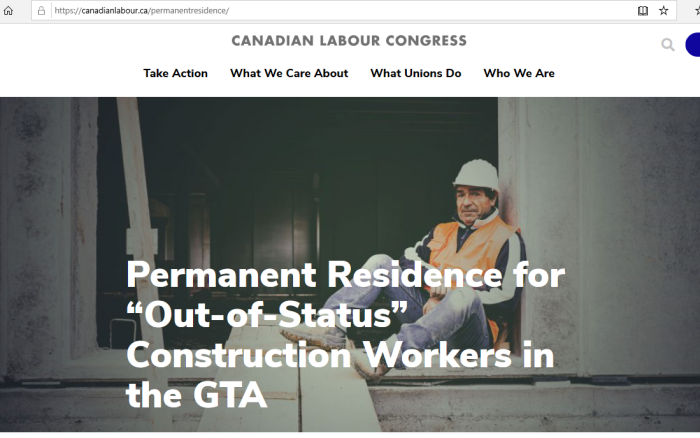
Ottawa, July 5, 2019 – Canada has launched a new temporary initiative to create a pathway to permanent residency for up to 500 out-of-status workers in the construction industry in the Greater Toronto Area (GTA). These construction workers have come to Canada and made contributions to its economy and currently have limited means to regularize their status.
Over many years, even decades, some workers who have come to Canada with valid temporary resident status, and who have filled labour shortages in the construction industry, have fallen out of status. Previous changes, such as “four in, four out”, have resulted in some workers losing their status. These workers have continued to address significant labour shortages in the construction industry, while also contributing to the economy and their communities. Without valid immigration status, these workers and their families have lived in fear and been left feeling very vulnerable. The presence of out-of-status workers in a significant industry leads to depressed wages for Canadians and makes workers vulnerable to employer exploitation and abuse.
The Canadian Government announced in July 2019 a pilot program to give 500 illegals (and their families) a pathway to permanent residence in Canada if they were to work in construction. Yes, we are talking about an actual amnesty program that will lead to PR, and eventual citizenship.
The Canadian Labour Congress supports this initiative. Why wouldn’t they? It will result in an inflation of workers, and allow employers to push down wages. It really is about more cheap labour.
This program is stated to target 500 people (and their immediate family members). But we should not be naïve. Once this is launched, the next question will be how to upscale it.
8. Government Making Illegal Entries Easier
This article isn’t really about illegal entry into Canada (see the Federal Court cases for more). Nonetheless, a major act of hypocrisy must be pointed out.
The Federal Government makes the absurd statements that the Canada/U.S. Safe Third Country Agreement is necessary to protect Canadian borders, but also claims that citizens have no standing to make a claim to close the loophole.
Yes, the agreement must be enforced at all border crossings, but if someone were to GO AROUND those checkpoints, then it is direct entry into Canada.
To summarize where we are right now in the article:
(a) About 25% of students/temps become permanent residents, and
(b) Canada doesn’t track people exiting the country
(c) CBSA cancels old arrest warrants
(d) Number of illegals in Canada is unknown
(e) Amnesty for illegals is starting up
(f) The Canadian Government wants to keep S3CA loophole open
Now that we have covered how the Canadian borders are at best dysfunctional, let’s take a dive into the research into just how many people are staying in Canada (legally). At least this will be considerably more definitive
9. Annual Reports To Parliament
Unlike permanent residents, temporary residents are in Canada for a limited time. This group consists of students, foreign workers and visitors, including tourists. Temporary residents contribute to Canada’s economic growth and to the vitality of our educational institutions.
Before coming to Canada, applicants must obtain a temporary resident visa, unless they are coming from a country that is exempt under the IRP Regulations. Visa officers consider a number of factors when evaluating temporary residents’ visa applications. For example, they can verify whether the visitor is in good health, has a criminal record, is a security threat to Canada, holds a valid passport or travel document, has enough money to live on while in Canada, and will leave voluntarily at the end of his or her stay in Canada. The visa officer evaluates the situation before deciding whether the applicant is a genuine visitor or if he or she might stay in Canada illegally. To that end, the visa officer studies the applicant’s reason for the visit, his or her employment, family situation, and the general economic and political stability of his or her country of origin.
(Page 22 of 2004 Report to Parliament)
Foreign Students
In recognition of the social and economic benefits that foreign students bring to Canada, the federal government has committed to making our country a destination of choice for talented foreign students. To obtain a study permit, candidates must submit an application to study in Canada. Applications must be submitted to and approved by a visa office outside Canada. The permit indicates the level of study and the intended duration of the visit. In general, foreign students must present an acceptance letter from the institution they want to attend, prove that they have sufficient money to pay their tuition fees and living expenses, satisfy the visa officer that they intend to return to their country of origin at the end of their studies and undergo a medical examination.
(Page 23 of 2004 Report to Parliament)
Worth noting that for “temporary” workers and students, the reports emphasize that these are to be temporary, and that the resident is expected to return to the home country afterwards. Remaining in Canada is not to be the goal.
One other point is that the 2004 report makes no mention of any temporary worker or student/graduate transitioning to permanent resident.
The 2005 report (page 29) reiterates that these temporary workers and students are expected to leave once their designated time is up. It is also stated that changes were made so student visas would be for the full duration of the program.
Pilot projects initiated in 2003 (in Alberta, New Brunswick and Manitoba) to test these program changes proved to be highly popular with international students, educational stakeholders and provinces. In 2004–2005, CIC signed agreements with Saskatchewan, Nova Scotia, and Newfoundland and Labrador to allow international students to work in Canada for a second year after graduation. An agreement was also reached with Quebec to allow students outside Montréal and Québec City to work off campus.
The 2005 report (page 31) talks about a rule change that allows some graduate to work in Canada for 2 years now after graduation. I’m confused. I thought the point was that these students were to return home after graduation, not work in Canada afterwards.
On April 18, 2005, the Minister announced initiatives to address some key issues facing international students. These included the expansion of the pilot projects mentioned previously that aim to better attract, integrate and retain international students in regions of the country in partnership with the provinces and educational institutions. The first pilot project will allow international students at public post-secondary institutions to work off campus while completing their studies so that they can experience the Canadian labour market and gain a greater understanding of Canadian society. The second pilot project will allow students to work in Canada for two years after their graduation, rather than one year. To help spread the benefits of immigration to more of Canada’s regions, this second initiative will apply outside Toronto, Montréal and Vancouver. The Government of Canada is investing $10 million a year for five years to support these new initiatives.
These students are supposed to be in Canada “temporarily”, but the Government makes rule changes so they can work in Canada afterwards. Almost like they can become permanent residents.
The limit on the number of provincial nominations was removed to give Saskatchewan greater flexibility in operating its immigration program.
The 2006 report (page 10) explains how Saskatchewan took off the cap of its Provincial Nominee Program.
CIC also launched a national initiative in April 2006 that allows foreign students enrolled full-time in post-secondary programs to seek employment off-campus.
The 2006 report (page 11) states that students enrolled full time in college or university programs are now allowed to work off campus.
Foreign Students
Foreign students bring with them new ideas and cultures that enrich the learning environment within Canadian educational institutions. Foreign students who enter Canada on temporary visas may also be an important source of future immigrants in the skilled worker category since they are well prepared for the Canadian labour market.
The 2006 report (page 23) states that students can be a valuable source of future immigrants. But I thought these “temporary” residents were going home after graduation.
Working with Human Resources and Social Development Canada (HRSDC), Service Canada, and the provinces and territories, we implemented a series of administrative improvements to the Temporary Foreign Worker Program. As announced in Budget 2007, we are developing ways to make it easier, faster and less costly for employers to access the workers that they need, while also introducing measures to ensure that employers comply with program terms and conditions. We are also developing the Canadian Experience Class, a new avenue to immigration that will, under certain conditions, permit foreign students with Canadian credentials and work experience, as well as skilled temporary foreign workers who are already in Canada, to apply for permanent residence.
The 2007 report (page 4) states 2 things.
First: new measures will be enacted to bring in cheap, foreign labour even faster and more cheaply.
Second: we’ll make temporary workers and students eligible for permanent residence.
As well, the Plan includes the introduction of the Canadian Experience Class, a new avenue to immigration that will permit, under certain conditions, temporary workers and foreign students with a Canadian credential to apply for permanent residence.
The 2007 report (page 9) reiterates the plan to make students and temporary workers eligible for permanent residence.
First-ever framework agreements were signed with Alberta on May 4, 2007, and with Nova Scotia on September 19, 2007. To meet the growing demand for labour, the limit on the number of immigrants that can be nominated through the PNP was removed, and the intention to develop annexes to facilitate the entry of temporary foreign workers was announced. In addition, a renewed PNP agreement with Newfoundland and Labrador, which came into force in November 2006, removed the limit on the number of provincial nominees.
The 2007 report (page 10) tells how Nova Scotia and Newfoundland and Labrador had their Provincial Nominee Program caps removed. Saskatchewan did so the year earlier.
Other initiatives in 2006 included policy and planning work to develop options for facilitating the transition from temporary to permanent status. This culminated in the announcement in Budget 2007 of a proposed new avenue to immigration by permitting, under certain conditions, foreign students with Canadian credentials and skilled work experience, and skilled temporary foreign workers who are already in Canada to apply for permanent residence. This will allow qualified individuals with Canadian skilled work experience, or with a combination of Canadian work and studies, to make the transition to permanent status. The program is expected to lead to improved economic outcomes for newcomers in this class.
The 2007 report (page 13) repeats the intention to make students and temporary workers eligible for permanent residence. It’s a common misperception that they will be going home afterwards.
We introduced the Canadian Experience Class, which offers qualifying temporary foreign workers and international students with Canadian work experience the possibility to stay in Canada permanently. This program will make our immigration system more responsive to Canada’s labour market by helping retain those temporary foreign workers and international students who have demonstrated their ability to succeed in Canada.
The 2008 report (page 5) repeats the pledge from the last report to make it easier for temporary foreign workers and students to transition into permanent residents.
As well, the Post-Graduation Work Permit Program was significantly improved by extending work permits from one to up to two years for international students who have graduated from public post-secondary institutions and certain private institutions located in regions outside of Montréal, Toronto and Vancouver. The aim is to help spread the benefits of immigration to more of Canada’s regions. During 2006–2007, a total of 1,388 students received two-year work permits. More broadly, the total number of students who received post-graduation work permits increased from 7,354 in 2005–2006 to 9,121 in 2006–2007. In 2007–2008, the number of post-graduation work permits issued increased to 10,933.
The 2008 report (page 28) talks of expanding the Post Graduate Work Permit Program from 1 year to 2, and of issuing more permits altogether. The goal is to “spread the benefits of immigration” as they call it.
There are many other passages in these reports obviously, that support the claim that “temporary” workers and students aren’t really temporary. However, the point has been made, so let’s move on to how many temps and students are transitioning to permanent residents. In these first 5 reports, there is no mention of any of it.
10. Transitioning To Permanent Residents
Intake of: (a) TFWP; (b) Int’l Mobility; (c) Students from 2015 to 2017

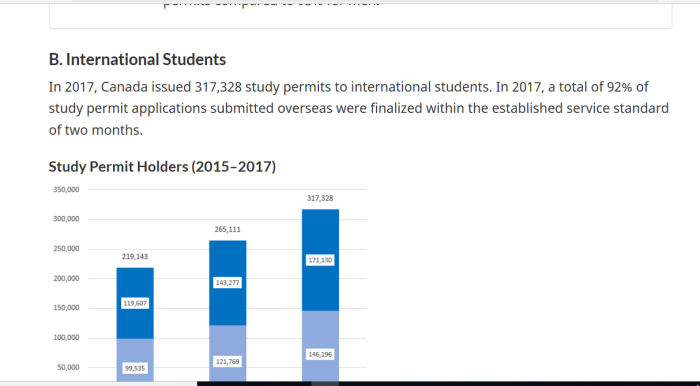
Transitions from Temporary Foreign Worker or International Student Status to Permanent Residence (from 2018 report, covering 2015 to 2017)
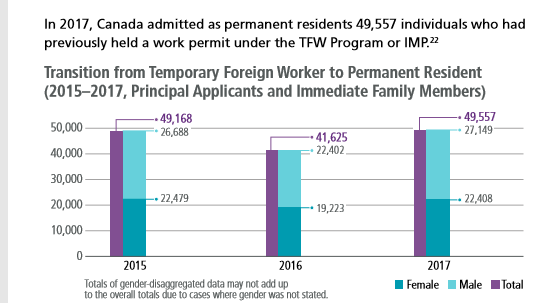

Not only are the numbers of students and “temporary” workers increasing, but they are obtaining permanent resident status in higher numbers.

The Provincial Nominee Program, which grants permanent residence, is a very common choice among post secondary school graduates.
Now, all of the above data comes from the 2018 Annual Report to Parliament on Immigration, and covers the years 2015 through 2017. But what about the longer term implications? In the big picture, how many students and temps are getting PR?
11. StatsCan Research On Transitioning Rates
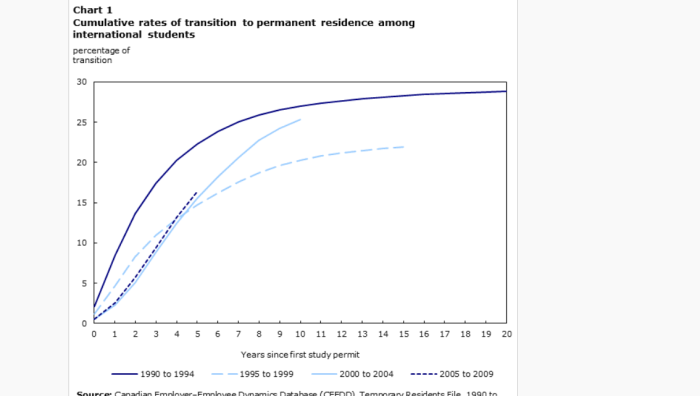
Transition to permanent resident status
International students likely come to Canada for various reasons. Some may intend to return to their home country once they have acquired their Canadian qualifications, while others may intend to remain in Canada for a period of time to obtain work experience in an advanced economy. Still others may hope to become landed immigrants and remain in Canada permanently.
It is possible to estimate the proportion of international students who become permanent residents by calculating a cumulative transition rate. The cumulative rate, which can be calculated for any cohort, is the share of international students who become landed immigrants a number of years after obtaining their first study permit.
For example, among international students who obtained their first study permit between 1995 and 1999, about 15% became permanent residents in the five years that followed. When the period of observation is extended to the first 10 years after the study permit was received, that proportion rises to 20%, and then to 22% by the fifteenth year (Chart 1).
Of the international students in the early 1990s (1990 to 1994), late 1990s (1995 to 1999) and early 2000s (2000 to 2004) cohorts, those in the early 1990s cohort were the most likely to subsequently become permanent residents in Canada. Over the 10 years after they received their first student permit, 27% of the early 1990s cohort became permanent residents, while this was the case for 20% and 25% of individuals in the late 1990s and early 2000s cohorts, respectively. The transition rates of international students in the late 2000s cohorts looked like those of the early 2000s cohorts over the first 5 years after receiving a study permit, but additional data must be accumulated to see whether this trajectory continues over the longer term.
In addition to varying across cohorts, rates of transition into permanent residence also vary across sociodemographic characteristics such as sex, age, level of study and source country. Again, transition rates by characteristic are examined at the tenth year after the first study permit is received (Table 2).
India and China are the top 2 source nations for student visas to Canada. This should be obvious to anyone who visits a college or university.
The research conducted by Yuqian Lu and Feng Hou is too lengthy to go over entirely here, but it is very interesting. Long term, is suggests that roughly a quart of international students will eventually become permanent residents of Canada.
An interesting fact noted: 49% of people who obtained a post-graduate degree (a Master’s) obtained PR status. It has to do with the added points in the immigration system.
12. When Exactly Did This Start?
But wait a minute. The above research by Yuqian Lu and Feng Hou cover international students that have transitioned to permanent residents since 1990. However, the Annual Reports to Parliament on Immigration spoke of this new option in 2006/2007. (See below)
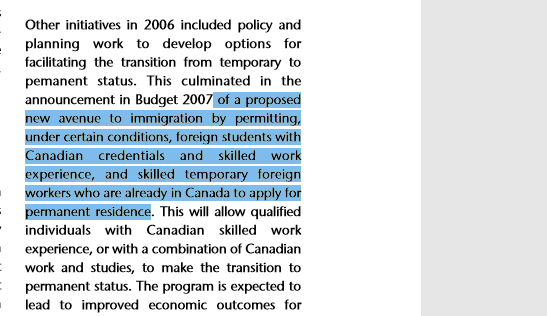
That is a screenshot from the 2007 report on page 13. It refers to this transition to permanent residence as something to happen in the future.

The transitions to PR have been happening under the Provincial Nominee Programs primarily. The announcement in the annual reports must have just been to boost the numbers, by adding other categories.
13. Transition Rates Increasing For Temps
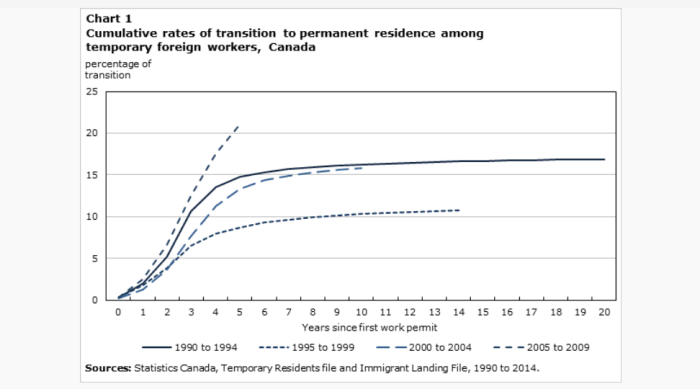
The 2005-2009 cohort, is the most recent one available from this StatsCan research, and could easily hit 25-30%, if the same pattern is demonstrated. This graphing attempts to demonstrate collect trends of transitioning to permanent residence after a given time.
Bear in mind, that new programs are available can boost this and future cohorts higher.
14. Most “Temp” Workers Had Current Status
Another StatsCan research piece documents the status of so-called “temporary” workers who held visas at or before the time that they transitioned to permanent residence.
It is broken into two periods: 1990 to 1999, and 2000 to 2009. Although it does not give the totals, as a percentage, around 87% of people who transitioned to permanent residence had current status.
Although the International Mobility Program existed well before the 2013 TFW scandal, participants were still able to become PR.
15. Students/Temps: 25-30% Will Get PR
Based on the information provided by StatsCan, it is safe to say that 25-30% of students and temporary workers will eventually get their Permanent Resident status. Transitions do start out at a fast rate, and understandably peter out. This is based on research done by some StatsCan researchers.
Now, a few caveats must be talked about here to make the picture more complete. This is not the end of the story.
First, rule changes by successive Federal Governments have expanded the number of programs, and eased the restrictions and numbers available. It stands to reason that rates will increase from what has been shown before. The information given about previous years may be obsolete.
Second, this information does not take into account people who have remained in the country but not transitioned to Permanent Resident status. While the common belief is that students will return home after their schooling is done, or workers will return home after their work term ends, that is simply not the case. Even StatsCan admits that people from lower GDP countries are more likely to stay given the higher standard of living in Canada.
Third, these findings do not consider people now living illegally in Canada. Inexplicably, we still have no real exit tracking system. As such, the Federal Government, or at least the Immigration Ministry, doesn’t know who is leaving Canada and when.
Fourth, this is all predicated on the assumption that the Government puts out truthful and accurate findings. This type of “backdoor immigration” system is not popular with the public, so minimizing the scale of it isn’t much of a stretch.
In short, 25-30% of temporary workers and students (officially) will stay in Canada. But take that conclusion with a grain of salt. It may be much, much higher.




